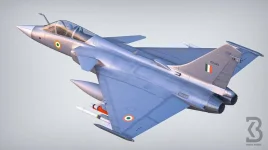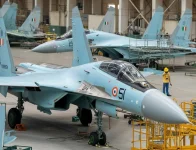- Views: 2K
- Replies: 22
India is facing an increasingly complex security situation, with the potential of a coordinated two-front threat from Pakistan and China.
The advancement of stealth aircraft technology in the region, highlighted by China's operational J-20 fighters and Pakistan's reported interest in acquiring Chinese J-35A jets, presents a significant challenge to Indian air superiority.
In response, strategic experts are pointing to Russia's next-generation S-500 "Prometheus" air defence system as a powerful countermeasure to safeguard Indian airspace.
Recent reports, though currently denied by Pakistan's Defence Minister, have indicated that the Pakistan Air Force (PAF) is exploring the purchase of 30-40 J-35A stealth fighters from China, with potential delivery by 2030.
This fifth-generation aircraft, featuring a low radar signature and advanced electronic systems, could enhance Pakistan's ability to conduct surprise strikes against India's critical military and civilian infrastructure.
This potential acquisition complements the existing deployment of China’s advanced J-20 stealth fighters at airbases near the Line of Actual Control (LAC), creating a formidable dual-front challenge for the Indian Air Force (IAF).
To address this evolving threat landscape, India is strengthening its multi-layered integrated air defence system.
A potential acquisition of the Russian S-500 Prometheus system is being seen as a crucial next step. This state-of-the-art platform, which is designed to work alongside the already inducted S-400 "Triumf" systems, would provide a significant boost to India's defensive capabilities and strategic deterrence.
The S-500 Prometheus: A Generational Leap in Air Defence
Developed by Russia’s Almaz-Antey Concern, the S-500 is a cutting-edge air and missile defence system designed to intercept a wide spectrum of aerial threats. It represents a significant advancement over its highly capable predecessor, the S-400.The first S-500 regiment entered service with the Russian military in 2021, and while Russia has not yet exported the system, it has indicated that India could be a prospective first partner.
Key capabilities of the S-500 system include:
- Anti-Stealth and Ballistic Missile Defence: The S-500 is engineered to detect, track, and engage low-observable targets like stealth aircraft at ranges up to 400-500 km. It can also intercept ballistic missiles at a range of 600 km and altitudes reaching into near space (180-200 km), making it a credible defence against Pakistan's Shaheen and Ababeel missiles, as well as some of China's DF-series missiles.
- Hypersonic and Anti-Satellite (ASAT) Capabilities: The system is designed to counter hypersonic weapons travelling at extreme speeds. Furthermore, its ability to target low-orbit satellites poses a direct threat to an adversary's reliance on space-based assets for navigation, surveillance, and communication, a critical component of modern warfare.
- Rapid Response and Mobility: With a reaction time of under four seconds and mounted on a highly mobile wheeled chassis, the S-500 can be rapidly deployed across India’s vast borders, from the western front with Pakistan to the northern borders with China.
Building an Impenetrable Air Defence Shield
The strategic value of the S-500 lies in its ability to be integrated with India's existing air defence network.By deploying two to three S-500 regiments alongside the five S-400 units already in service, India could establish a nearly impenetrable air defence shield. This network would protect major cities, industrial centers, and vital military installations.
This Russian system would be further complemented by India's own indigenous developments. The DRDO is actively developing "Project Kusha," a long-range surface-to-air missile (LRSAM) system.
With interceptors planned for ranges of 150 km, 250 km, and 350 km, Project Kusha is designed to be integrated into the IAF's Integrated Air Command and Control System (IACCS), creating a seamless, multi-layered defence.
The combination of the S-500's unparalleled range and anti-stealth features with the S-400 and the indigenous Akash, Barak-8, and Project Kusha systems would provide India with a robust defence against the combined stealth air threat from its neighbours, ensuring it maintains a strategic edge in the region.
While discussions for the S-500 remain at a preliminary stage, its potential acquisition represents a critical component of India's strategy to deter aggression and secure its skies for the foreseeable future.


